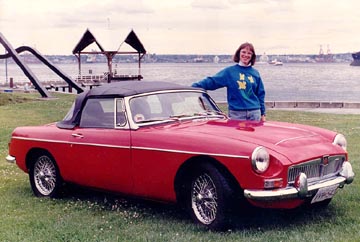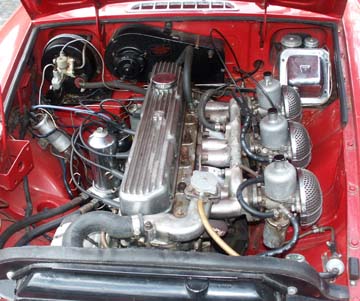layout: front engine, rear-wheel drive
engine: 1798cc inline-4
horsepower: 79
transmission: 4-speed w/optional OD
suspension: independent front, live axle rear
brakes: disc front, drum rear
wheels: 14x5.5-in.
tires: 155-14
weight: 2260 lbs.


Photography Credit: Courtesy Moss Motors
[GRM+ members read this article first. Subscribe and gain access to more exclusive content for only $3/month.]
Why does the Miata work so well? It’s a reliable, open-top sports car that you can buy today for very fair prices. The MGB is pretty similar, but in an older, traditionally British package–more chrome, more charm. In a world where ’60s icons can easily cost more than a three-bedroom house, the MGB provides an affordable path to classic sports car ownership.
When the MGB burst onto the scene for the 1962 model year, it gave enthusiasts a modern roadster that didn’t break the bank. The MGB featured an easy-to-use folding convertible top, independent front suspension, up-to-date looks and a usable trunk. Where most of its contemporaries relied upon body-on-frame construction, the MGB featured a unibody.
Power came from a 1.8-liter inline-four fed by a pair of tried-and-true SU carburetors–enough for a top speed of 100 mph, plenty fast for the day. MG soon offered an optional overdrive for the standard four-speed transmission. The car immediately became a crowd favorite.
The first big change came for 1966 when the hardtop GT joined the model line. As if the MGB roadster weren’t enough, buyers could now option for the smartly styled GT. It even offered a tiny rear seat for equally tiny passengers.
For the 1968 model year, the MGB got another update. The easiest way to identify a post-1967 car? Look for three windshield wipers. That year, MG also swapped the generator for an alternator, while the all-steel dash received a padded vinyl cover in the name of safety.
Planned replacements for the MGB never happened–call it a victim of budget issues and corporate politics–so MG just kept updating the car through the years.
Another significant change happened partway through the 1974 model year. In order to meet the day’s crash standards, the original chrome bumpers were replaced with big, black, rubber pieces–technically they’re formed in urethane, but most people refer to the MGBs wearing them as rubber-bumper cars.
At the same time, MG raised the ride height by about an inch and a half to meet U.S. headlight requirements. Soon after, there was a switch to a single Zenith/Stromberg that cut some horsepower.
Despite the drop in performance, the MGB soldiered on until the 1980 model year. Figure they built about 15,000 to 25,000 roadsters per year, with most leaving England. Add in the GT figures, and MGB production tops half a million units.
[What Makes a Great Sports Car?]
Today, the cars are still hugely popular. Club support remains strong, and almost every repair and replacement part is still available–even brand-new body shells built on the original tooling.
Want to see how sports car enthusiasts did it in the ’60s and ’70s? The MGB could be your personal time machine.
Longtime GRM regular Carl Heideman knows a few things about the MGB. His shop, Eclectic Motorworks, has restored and serviced many over the years.
Rust is an issue with most MGBs, so unless you find a well-cared-for car from a dry climate, expect to either deal with rust or deal with previous repairs. Literally every panel is available for these cars, although some do require finesse to fit. If you choose to make your own repairs, books, clubs, and the Internet offer a lot of support. Several hands-on training options are available as well. If you hire a shop, it’s wise to use one that’s nationally known and has done 10 or more MGBs. That level of experience will usually keep the price and quality in line.
[4 ways to tackle rust | Good, better, best, ideal]
Electrical issues are almost always overstated. Most problems are due to corroded connections, especially at the battery, the starter and the fusebox. Additionally, Lucas bullet/barrel connectors will corrode over time. Cleaning terminals and grounds as well as replacing corroded Lucas barrels will correct most issues. Of course, previous workaround “repairs” can be an issue. Returning to stock wiring is usually the best repair.

MGB handling, while criticized for its lever shocks and leaf springs, is pretty good as long as everything is in good shape. Kingpins and bushings often need to be replaced in the front end, lever shocks can be rebuilt and upgraded, and springs can be replaced or rebuilt. There have been long periods where the market was flooded with poor-quality springs, so “new” ones can be suspect. Current coil springs seem acceptable, and leaf springs are often better rebuilt at a local spring shop.
Like Lucas electrics and lever shocks, SU carbs get blamed more than they deserve. Most carb problems start on the ignition side, and almost all distributors are worn or have a bad timing curve for today’s fuel. A new or rebuilt distributor with properly rebuilt carbs (including throttle shafts and bushings) makes a tune-up easy and long-lasting.]
[SU or Weber Carburetors? | Answering a timeless question]
Details make a difference in how much you enjoy an MGB. Seat cushions and supports will wear even while the upholstery continues to look good. Pedal bushings and worn components will induce sloppy-feeling free play. Minor rattles from mirrors, loose door latches and other components will make a car feel worn out. Tackling these issues one at a time makes for easy weekend projects that are worth the effort and small expense.
This hardly needs to be repeated, but the reason the Miata was such a hit was that it offered the roadster experience in a package that didn't break down every day. The only reason someone would acquire an old MG today is brain damage, a tendency towards masochism, or an inordinate affection for chrome. Or all three.
Not that there's anything wrong with that....
I always know when the vintage British car meet is in town, because I see them by twos and threes....usually sitting on the side of the interstate, (probably) loving every minute of the experience.
There is a whole generation of car enthusiasts that won't appreciate that just arriving at your destination is an accomplishment. :)
Funny how as cars get better the human race gets wussier. I have been driving Brit cars since the days when they were just another car on the road. Year round in Canada. They were no better or worse than a lot of the NA offerings that toottled along with one wheel drive every time it snowed. The tiny cabin actually warmed up quick once the car was warm.
MGBs failed to make the money train when poorly built cars like the Healey that went on to make bank for those that kept one around.
A properly restored MG is just as reliable as a well cared for Miata. However a "crap"box is a " crap"box no matter what year or manufacturer. The MGA was specifically cited by Tom Mitano for the driving experience he wanted in the Miata. The shifter - shared with the MGB with a slightly longer shift lever - was singled out for being excellent. The MGA and later the MGB was the quintessential cheap, fun, easy to work on, car. Which has also happened with the Miata. As the owner if both a autocross prepared MGA and an NB, handling and feel between the two is very similar.
Alright, I'll bite. I've owned MGBs since the 1980s and like NOHOME used to daily drive them as much as 25000 miles per year (in Michigan winters, too). They took about as much maintenance as any other car at the time and I always contend the main issue with reliability was that the carbs and some of the electrical equipment was just different enough that repairs or workarounds from inexperienced people caused most of the reliability issues.
These days I have an embarrassing number of cars and some days I play Which Car Will Start and my 1978 MGB always does (so do my other British cars). It sees about 1000 miles a year these days and I change the oil every year, look at the brakes every 5 years or so, and occasionally some little thing breaks, like a window winder.
I find it hard to believe no one openly labled Lucas with the 'prince of drarkness' moniker. Or openly cursed the su carbs.... i will say i never owned one but had friends who did and openly turned the air blue all too frequently when referring to these 'features' whether in polite company or not.
The MGB is a decent enough sports car - I have owned a couple - but the MGA is a classier body style, though you have to go for the coupe version if you want modern weather gear.
There is one version of the MGB I did take to though - The MGC, which looks like an MGB ith a bump on the bonnet and carries a completely different (torsion bar) front suspension and a 6 cylinder engine, unhappily throttled by smog provision - supposedly they have 145 bhp but really have around 130.
I built one for my wife to drive and modified the engine lightly - triple carbs and mild cam etc., plus hand made headers - result was 175 bhp and 130 mph top end. The way the factoruy should have done it in the first place.


In reply to David S. Wallens :
Funny how the independent front suspension is exactly what was introduced in 1950 with the MGTD.! Well, disk brakes instead of drums but if you wanted you could put those drums on the MGB. Then just for the sake of not wasting parts you could put those disk brakes on that MGTD or a TF, MGA? I love the MG parts bin.
livinon2wheels said:I find it hard to believe no one openly labled Lucas with the 'prince of drarkness' moniker. Or openly cursed the su carbs.... i will say i never owned one but had friends who did and openly turned the air blue all too frequently when referring to these 'features' whether in polite company or not.
Those SU carbs are easier to work on than a lawn mower carb. Once properly adjusted last for decades if not messed with. 95% of the carb problems are simply failure to set the point gap properly.
Same with the SU fuel pump. Beat on it with a stick idiots say. Smart owners keep a piece of ultra fine emery paper filed over and with every oil change slide it through the fuel pump points. Mine is going on 40 years without a problem. Oh, it does add 2 minutes to the oil change time.
My MG is going on 70 years old ( same suspension ) and it's all original. See you have to grease those parts. Not periodically replace them. Like modern cars.
As far as Lucas parts. Again a little bit of knowledge will get you trouble free life. Most "Lucas" problems are simply poor connections. Those little bullet connectors have no weather proofing. So periodically you take them apart, remove the corrosion, coat them with a high dielectric grease and get another decade out of them. While you're at it check the grounds. Copper on steel will corrode over time so clean and grease those as well One rainy afternoon in the garage will keep any British car happy for a year. Seems like a fair deal to me. But then I've owned my MG since 1962. Raced it at least 20 times in vintage sports car races. And put over 50,000 miles on it since 1974.
Displaying 1-10 of 44 commentsView all comments on the GRM forums
You'll need to log in to post.